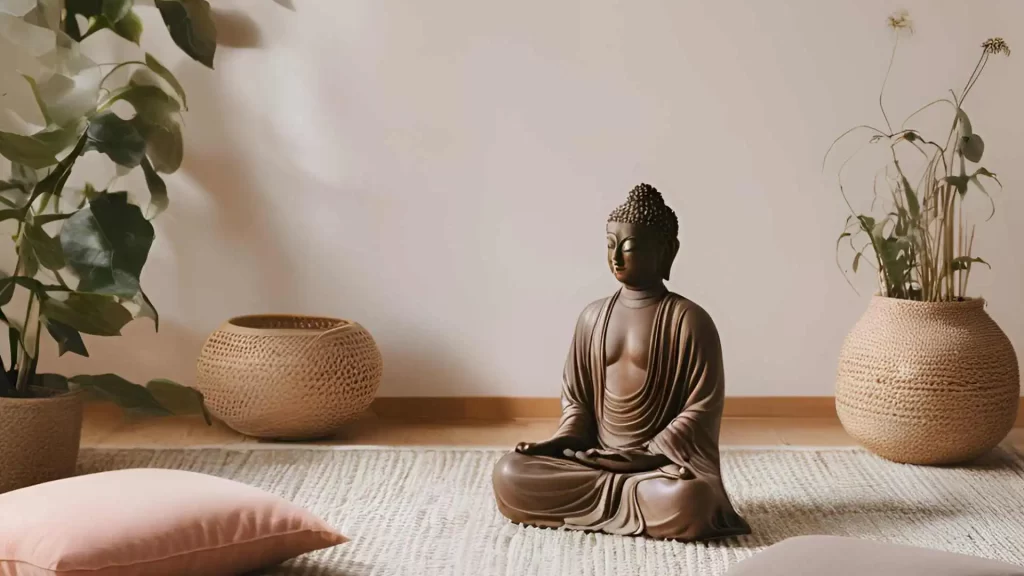In our everyday lives, we often encounter moments where things happen on autopilot. We rush through our days, overwhelmed by a barrage of thoughts and a relentless pace of living. We seldom find ourselves fully immersed in the present moment. This is where mindful living can make a transformative difference.
“Realize deeply that the present moment is all you have. Make the NOW the primary focus of your life.”- Eckhart Tolle
What is Mindful Living?
Mindful living is about embracing the present moment and living with intention. It involves fully engaging with what we are doing right now, rather than being lost in thoughts about the past or future. Thich Nhat Hanh, a renowned mindfulness teacher, beautifully encapsulates this concept. He teaches that mindfulness is the art of living deeply in the present moment, truly being alive and aware of the beauty around us.
Living mindfully means paying attention to our thoughts, emotions, and actions without judgment. It’s about cultivating awareness and appreciation for the here and now. This practice enables us to break free from the autopilot mode and leads to a more deliberate and meaningful life.
The Benefits of Mindful Living
When you start living mindfully, you begin to experience profound changes in various aspects of your life:
Shutting Down Negative Thoughts: Mindfulness helps you recognize your thought patterns. By recognizing negative thoughts, you can address and manage them more effectively, reducing their impact on your mental well-being.
Keeping a Check on Your Habits: By being more present, you become more aware of your habits, both good and bad. This awareness allows you to make conscious choices about which habits to cultivate and which to change.
Better Awareness of Time Usage: Mindful living enhances awareness of how you use your time. It encourages you to prioritize activities that align with your values and goals, leading to a more fulfilling life.
Letting Go of Worries: Mindfulness teaches you to focus on the present moment rather than being consumed by worries about the future or regrets about the past. This shift in focus can significantly reduce anxiety and stress.
Mindful Living in Our Everyday Lives

Do you sometimes wonder if you’ve already added salt to the dish you’re preparing or forget why you opened the fridge? I do. These moments often indicate a mind overwhelmed with distractions.
So, mindfulness helps transform these daily activities into opportunities for clarity and peace. For instance, while taking a shower, focus on the feeling of warm water cascading over your skin, the scent of your shampoo, and the sound of water hitting the tiles.
When you’re driving, tune into the sensation of your hands on the steering wheel, the hum of the engine, and the view passing outside your window.
Even a simple task like making a cup of tea can become a mindful ritual—listen to the water boiling, watch the tea leaves unfurling, and savor the first warm sip. By engaging fully in these moments, noticing the small details, and letting go of extraneous thoughts, you can cultivate a more grounded and serene state of mind.
Mindfulness is a practice that develops over time. It’s not about achieving a state of constant peace, but about making a continuous effort to be present and engaged. To incorporate mindfulness into your daily life, you can start with a few simple practices.
Morning Rituals: Starting the Day with Intention
How we start our day sets the tone for everything that follows. Incorporating mindfulness into our morning routine can create a solid foundation for the rest of the day.
Mindful Breathing: Upon waking, take a few moments to focus on your breath. Sit up comfortably, close your eyes, and take deep, slow breaths. Feel the air entering your nostrils, filling your lungs, and then gently exhaling. This simple practice centers the mind and prepares you for the day ahead.
Gratitude Practice: Before getting out of bed, think of three things you are grateful for. These can be as simple as the comfort of your bed, the opportunity of a new day, or the sound of birds outside your window. Gratitude shifts the focus from what we lack to what we have, fostering a positive mindset.
Mindful Eating: If you have breakfast, eat it mindfully. Pay attention to the colors, textures, and flavors of your food. Chew slowly, savor each bite, and appreciate the nourishment it provides. This practice not only enhances the enjoyment of eating but also aids digestion and prevents overeating.
Incorporating Movement: Moving your body is a great way to practice mindfulness. Engage in activities that require physical presence and focus, such as yoga, tai chi, or even a simple morning stretch. Pay attention to the sensations in your body as you move, and let this awareness bring you into the present moment.
Related: 50 Mindfulness Quotes to Help You Slow Down
Commuting Mindfully
Commuting often feels like a necessary evil, filled with stress and impatience. However, with mindfulness, even this part of the day can become an opportunity for peace and reflection.
Mindful Driving: If you drive, try to stay fully present while behind the wheel. Focus on the sensations of driving—the feel of the steering wheel, the sound of the engine, the sights around you. Avoid distractions like the radio or phone. This not only makes driving safer but also more enjoyable.
Public Transport: If you take public transportation, use the time to practice mindfulness. Observe your surroundings without judgment, listen to the sounds around you, and feel the movement of the bus or train. You can also practice mindful breathing or engage in a short meditation using a mindfulness app.
Bringing Awareness to Your Professional Life
Work can be a significant source of stress, but integrating mindfulness into your workday can enhance focus, productivity, and job satisfaction.
Mindful Start: Begin your workday with a few minutes of mindful breathing or a brief meditation. This practice can help clear your mind and set a focused, calm tone for the tasks ahead.
Single-Tasking: In a world that glorifies multitasking, try focusing on one task at a time. Give your full attention to the task at hand, and notice how this improves the quality of your work and reduces stress.
Mindful Breaks: Take short, mindful breaks throughout the day. Step away from your desk, stretch, take a few deep breaths, or take a short walk. These breaks can rejuvenate your mind and body, making you more productive in the long run.
Mindful Evening Routine
As the day ends, mindful practices can help you transition from the busyness of the day to a state of rest and relaxation.
Mindful Reflection: Spend a few minutes reflecting on your day. Ask yourself what went well, what challenges you faced, and what you learned. Reflecting mindfully helps you process your experiences and gain insights without self-criticism.
Digital Detox: Limit your exposure to screens at least an hour before bed. The blue light emitted by phones and computers can interfere with your sleep. Instead, engage in a calming activity like reading, journaling, or listening to soft music.
Body Scan Meditation: As you lie in bed, perform a body scan meditation. Starting from your toes, slowly move your attention up through your body, noticing any areas of tension and consciously relaxing them. This practice can ease you into a restful sleep.
Related Post: How to Create a Mindful Night Routine
Mindfulness in Relationships
Mindfulness can profoundly enhance our relationships by fostering deeper connections and better communication.
Active Listening: Practice fully listening to others without interrupting or planning your response. Focus on the speaker’s words, tone, and body language. This not only shows respect but also deepens your understanding and connection.
Empathy and Compassion: Mindfulness helps us develop empathy and compassion by allowing us to see things from others’ perspectives. When conflicts arise, take a moment to breathe and approach the situation with a calm, open mind.
Mindfulness in Other Daily Activities
Screen-Free Hobbies: Incorporate screen-free hobbies into your day. Whether it’s reading, painting, gardening, or playing a musical instrument, these activities can help you disconnect from digital distractions and reconnect with the physical world around you.
Mindful Cleaning and Cooking: Transform everyday chores into opportunities for mindfulness. When cleaning or cooking, focus on the task at hand. Notice the textures, smells, and sounds involved in the process. This practice makes these tasks more enjoyable and turns them into moments of mindfulness.
Taking a Nature Walk: Spending time in nature is one of the most effective ways to cultivate mindfulness. Go for a walk in a park or any natural setting. Pay attention to the sights, sounds, and smells around you. Notice the feeling of the ground beneath your feet and the movement of your body as you walk. This practise is also known as walking meditation.
Enjoying Your Tea with Relaxing Music: Take a moment to enjoy your cup of tea or coffee mindfully. Sit down, relax, and savor the experience. Pair it with some relaxing music, and allow yourself to be fully present in this simple pleasure.

Playing with Your Pets: Pets can be great mindfulness companions. Spend quality time with your pets, playing or simply being with them. Notice their behavior, their movements, and the joy they bring into your life. This practice can ground you in the present moment and fill you with happiness and peace. My cats, Lili and Lalu, are my mindfulness companions.
To Conclude….
Mindful living is an ongoing journey, not a destination. It requires patience, practice, and a commitment to being present. Incorporating these mindful practices into your daily routine opens the door to a more balanced, peaceful, and fulfilling life. Remember, the goal is not to achieve perfection but to make a continuous, conscious effort to be present and engaged in each moment. As Thich Nhat Hanh says, “The present moment is the only time over which we have dominion.” Embrace it fully, and let mindfulness transform your everyday life.



